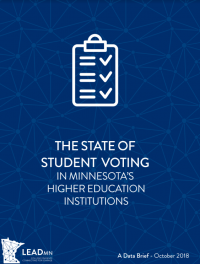Introduction
In the 2018 election, a wave of young voters turned out in record-setting numbers across the country. According to data from the Center for Information and Research on Civic Learning and Engagement (CIRCLE) at Tufts University, young people dramatically increased their turnout to 28.2%1 nationally. This increase had a profound impact on congressional and state legislative races. This was the case in Minnesota where CIRCLE ranked the state as having the highest youth voter turnout in the country at 43.7%, almost doubling turnout from the 2014 election (which was 20.7 points higher).
Minnesota’s youth voter turnout outpaced the turnout increase from the general electorate from 2014-2018, providing evidence that there was truly a youth wave in Minnesota. These trends show signs that Minnesota is building the strong civic culture that is key to growing voters. This is centered around the idea that just “motivating” young voters is purely transactional and that if we want to rebuild our democracy, we should cultivate young people to translate their voice into the voting process. Growing voters is a paradigm shift which seeks to make voting habit-forming in young people through a long-term approach of civic education, creating civic agency, and tearing down institutional barriers that prevent students from voting. We know that voting is habit-forming and that when young people learn about the voting process and participate now, they are much more likely to do so throughout their life. It is clear that encouraging college students to vote now is critical to the future of our democracy.
This report will examine the voting rates of Minnesota’s community college, state universities, and private universities for the past three elections. This data will help us understand the current state of youth voting and identify areas for improvement if Minnesota is going to continue to lead the country in student voting participation.
Methods
This report contains the voter registration and voting rates of the student body of each campus eligible to vote and those that actually voted in the 2014, 2016, and 2018 elections. Data was pulled from the national Study for Learning, Voting and Engagement (NSLVE) state cluster and campus reports. The NSLVE reports compare enrollment records that campuses submit to the National Student Clearinghouse and the voter files gathered by Catalist, a national data service firm. The team at NSLVE then estimates the number of non-resident aliens according to the IPEDS data. The data does not exclude the number of resident aliens and undocumented students, potentially causing some campuses to have a voting rate higher than what is reported.
A special thanks to the team at NSLVE for pulling together this data for Minnesota, and the Students Learn Students Vote Coalition for supporting the creation of this report. The NSLVE program was launched in 2013. As of the publication date, 1,141 institutions across the country have participated in the program with a diverse cross section of 2-year public institutions, 4-year private institutions, and 4-year public institutions.
The Students Learn Students Vote Coalition promotes civic learning and engagement on campuses across the country by providing a series of key steps and information on best practices that institutions can use to create a more voter friendly campus.
Next page >> Voting Trends Across Minnesota’s Higher Education Institutions
